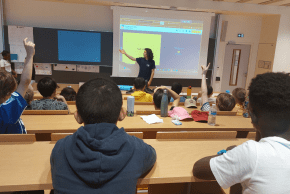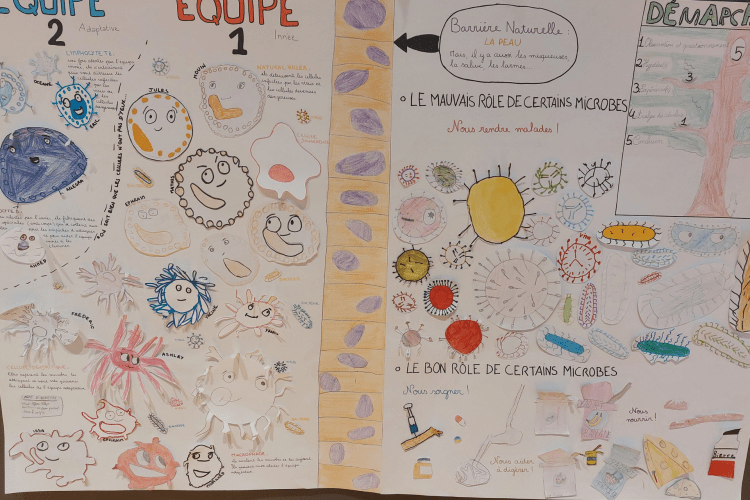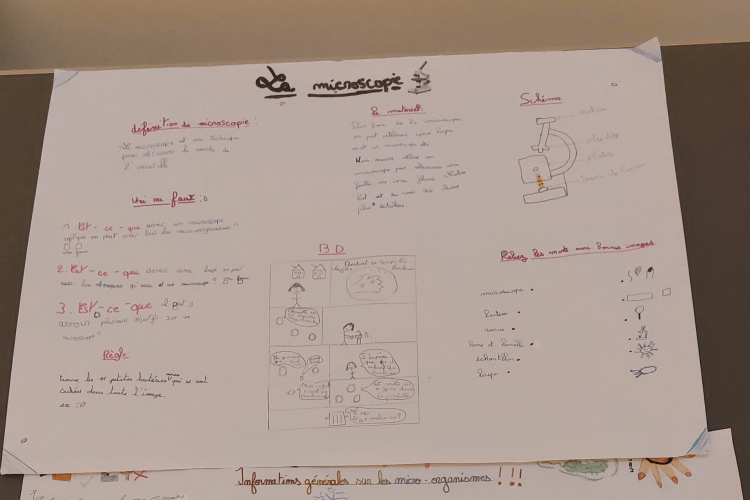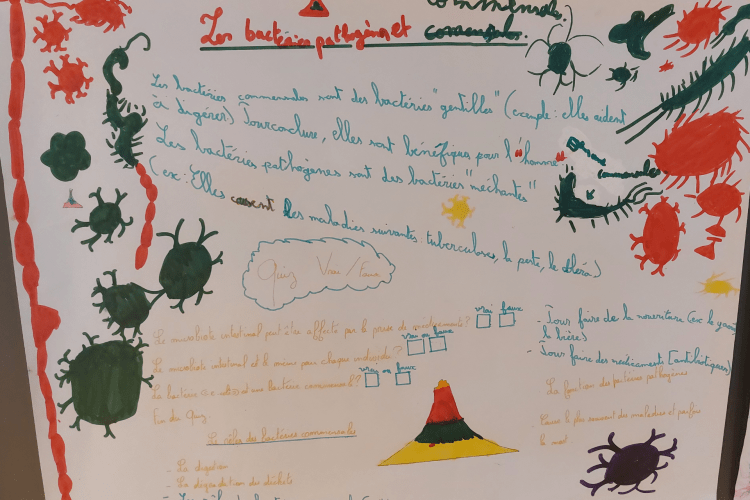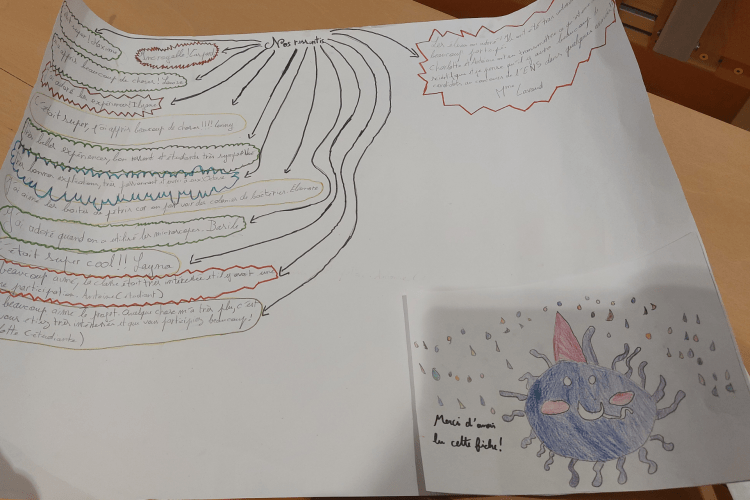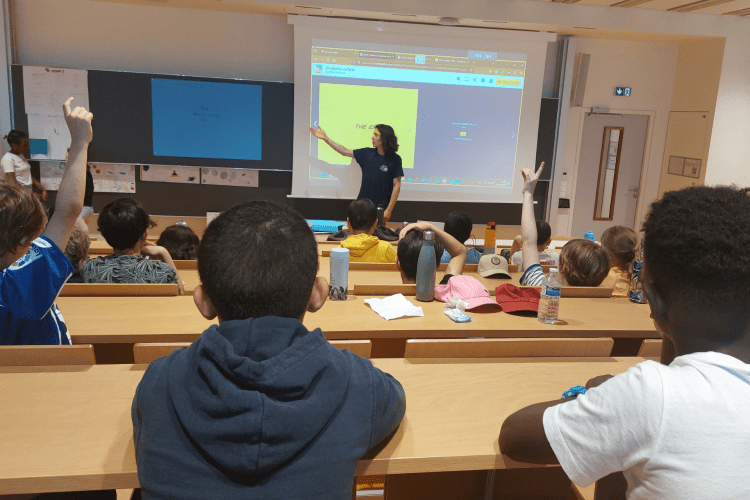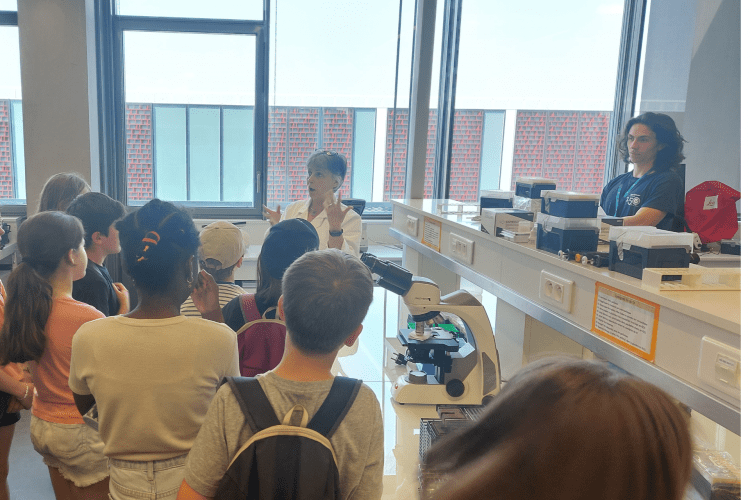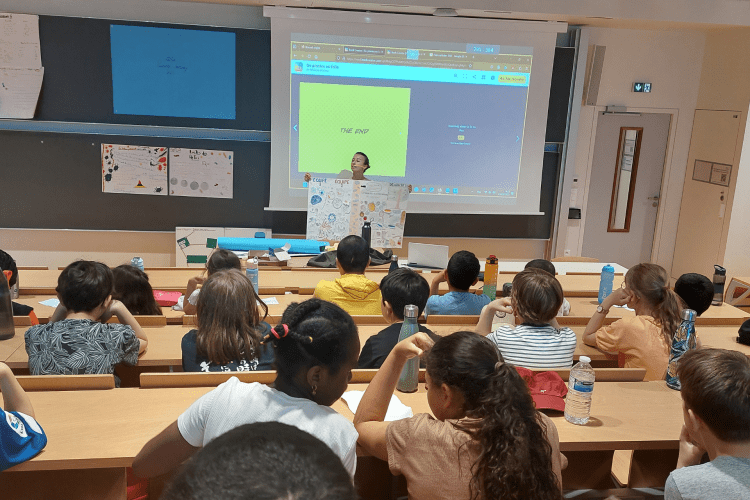This event marked the end of a pedagogical mentorship project led by six second-year ENS students: Alyssa Auvaro, Maylis Toumi, Quentin Rougeon, Camille Rigaudias, Charlotte Herbert and Antoine Hoareau. In pairs, these six students taught the elementary school classes for four sessions. These interventions introduced the young students to experimental sciences, and sparked their curiosity throughout a varied and interactive series of pedagogical activities.
Different sciences, concrete experiments
Each pair offered a different approach, providing the school children with a variety of points of view. Each session allowed the children to discover scientific observation and experimentation. Here are a few examples:
- A plant’s life cycle: the children explored the life stages of a plant, from seed to bloom and fruiting, by collectively designing a diagram.
- Conditions for germination and growth: the children designed an experimental protocol to test the impact of water, light, temperature and soil type on germination. In small groups, they calculated germination rates and followed the growth of their seedlings, designed graphs, analyzed results and debated on the reasons for the success or failure of the experiment depending on certain conditions.
- Microorganisms and the invisible world: through a quiz and observing microscopic images, the children learned about bacteria, fungi and viruses, and how to situate them in the living world. They classified different elements (bodies, organs, cells, bacteria, viruses) by size to better understand the microscopic world.
- “Nice” and “Mean” microbes: the children explored the varied roles of microorganisms, from beneficial bacteria in the intestine or to make yoghurt, to pathogens responsible for disease. They conducted an experiment on bacterial and fungal cultures in Petri dishes, from samples collected on their hands or on everyday objects.
- The immune system, hygiene and protective measures: the children discovered that our body possesses natural barriers—such as the skin, tears, saliva, mucous membranes—that protect it from microbes. They learned how to differentiate the two “teams” of the immune system, innate and adaptive, and why wounds become red, hot and swollen. To illustrate the importance of these barriers, they conducted an experiment with pepper and soap by observing how pepper in water is instantly repulsed by soap. They then discussed the effectiveness of washing one’s hands.
Learning the scientific method, step by step
During this project, the ENS students shared much more than their knowledge: they taught the children how to follow the scientific method. Each activity and workshop followed the main steps of the method:
- Ask questions: Why must we wash our hands? Where are bacteria found? What does a seed need to grow?
- Formulate a hypothesis: If I wash my hands for a long time, will there be less bacteria on them?
- Experiment: design a protocol, conduct an experiment (bacterial culture, soap test, plant a lentil or bean seed…).
- Analyze results: observe Petri dishes, compare differences between groups.
- Conclude: draw conclusions and answer the initial question.
A finale at the School under the sign of exploration
The project was concluded by a half-day’s visit to the School, accompanied by parents and teachers. The program included:
- A restitution of the work done throughout the project: the children presented scientific posters, an interactive comic strip and a filmed interview shedding light on what they learned and liked the most about the experience. This was a great occasion to celebrate their work and strengthen their self-confidence. The work done by the 5th graders was given great attention to, being restituted in an interactive e-book. In a fun and structured way, this medium shines light on the links between the experiments conducted in class and the scientific notions explored.
- A visit of the biology department’s laboratory and practical work labs, where the children discovered scientific equipment and the safety measures.
- A treasure hunt to discover the campus with an orthonormal and coordinated map. Alain Aspect Amphitheatre, the Kokarde (K-fet), Germaine Tillion Atrium… each location was a new adventure!
- A friendly picnic where children, parents and teachers discussed their experience of science, asked questions, talked about the experiments conducted, and shared their feelings about the project.
The children’s and teachers’ comments show how successful the project was: “I loved the Petri dishes,” “It was so cool to draw microbiotes”, “I loved the experiments and the quiz on microbes,” “I learned so much about science,” “I loved the field trip to observe bugs.”
Transmitting, inspiring, sparking a calling
Beyond education, this project created bridges between higher education and primary school, by fostering a passion for science in young minds. For the six ENS students who led the project, it was also a precious human and pedagogical experience:
“It taught us to improve our didactic skills, to adapt to stay as rigorous as possible while keeping our audience interested. It was so rewarding.” Antoine Hoareau
For Alyssa Auvaro, this project is also a concrete way to fight misinformation about health by raising awareness of beneficial microorganisms and of the importance of vaccines. She also sees it as an opportunity to show that science is for everyone and encourage young girls to pursue a field still dominated by men.
Quentin Rougeon: “This project is political, because it allows primary school students to fight fallacies. By learning about the experimental method, they learn that science itself can be biased and that one must remain critical. It is a precious initiation to the scientific method, as well as to what it means to be part of society; it is directly linked to greater societal issues.”
With the support of the ENGIE Foundation, this kind of initiative illustrates the ENS Paris-Saclay’s determination to share knowledge, to encourage scientific curiosity and to open the doors to research for everyone.
Do you wish to support future pedagogical and scientific projects? Contribute to the development of the School’s programs by making a donation today.
